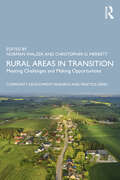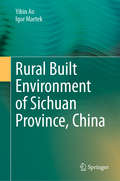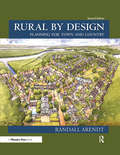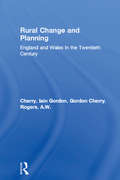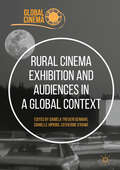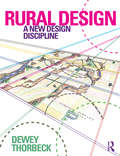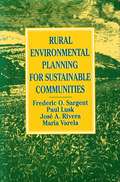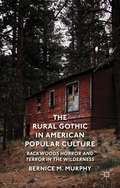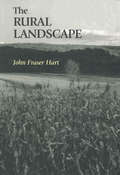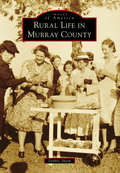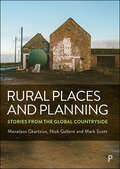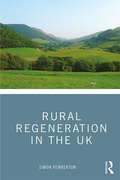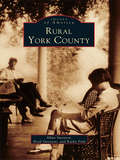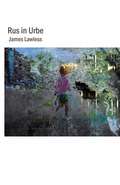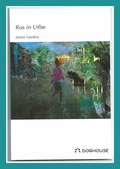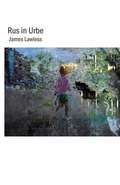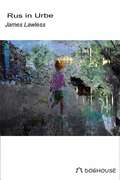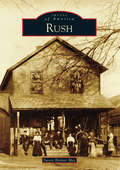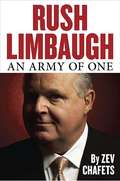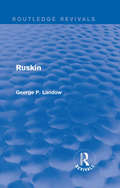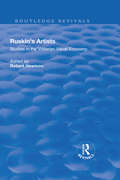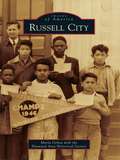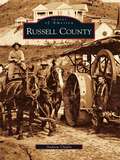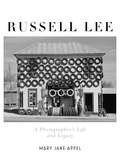- Table View
- List View
Rural Areas in Transition: Meeting Challenges & Making Opportunities (Community Development Research and Practice Series)
by Norman Walzer Christopher D. MerrettThis volume explores new opportunities to reshape local economies in rural areas during the next decade by exploring successful efforts already underway. While reported population declines can paint a bleak picture for rural areas, a different story can be told in looking at the numbers of households, employment, and housing markets. In fact, many rural areas have had steady employment and healthy housing markets. Rural attractions often include proximity to natural recreation areas, personal safety, social interaction, less expensive housing, and high-quality education. This book shows that rural areas are in a major long-term transition and that local leaders who take advantage of these opportunities in their community and economic development strategies can create a very positive future for residents. Students and policymakers in local economic development, sociology of population change, business finance, political economy, and geography will find this a useful resource.
Rural Built Environment of Sichuan Province, China
by Yibin Ao Igor MartekMajor changes are taking place in the Chinese countryside as China rushes to modernizes and urbanizes its rural fabric. The transformation is improving the quality of life of rural inhabitants, but also brings about challenges as people strive to adjust. This book systematically examines the impact of change on the daily lives and activities of the residents of Sichuan Province, in China’s South-west. It examines the themes of infrastructure, transport modes and preferences, sanitation, water conservation, earthquake and flood disaster preparedness, and the impact these have on villager behavior and quality of life. This book is an essential reference guide for graduate students and practitioners in the fields of rural planning, renewal, and construction.
Rural by Design: Planning for Town and Country
by Randall ArendtFor America’s rural and suburban areas, new challenges demand new solutions. Author Randall Arendt meets them in an entirely new edition of Rural by Design. When this planning classic first appeared 20 years ago, it showed how creative, practical land-use planning can preserve open space and keep community character intact. The second edition shifts the focus toward infilling neighborhoods, strengthening town centers, and moving development closer to schools, shops, and jobs. New chapters cover form-based codes, visioning, sustainability, low-impact development, green infrastructure, and more, while 70 case studies show how these ideas play out in the real world. Readers —rural or not—will find practical advice about planning for the way we live now.
Rural Change and Planning: England and Wales in the Twentieth Century (Planning, History and Environment Series)
by Gordon Cherry A.W. RogersThis book provides a critical overview of rural change over the eighty years since the outbreak of the Great War, making clear the historical origins of present-day policy. It also provides a structural integration for the many diverse themes which must be interwoven in order to understand current conditions in the countryside.
Rural Cinema Exhibition and Audiences in a Global Context (Global Cinema)
by Daniela Treveri Gennari Danielle Hipkins Catherine O'RaweAlthough it has only been in the last decade that the planet’s population balance tipped from a predominantly rural makeup towards an urban one, the field of cinema history has demonstrated a disproportionate skew toward the urban. Within audience studies, however, an increasing number of scholars are turning their attention away from the bright lights of the urban, and towards the less well-lit and infinitely more variegated history of rural cinema-going. Rural Cinema Exhibition and Audiences in A Global Context is the first volume to consider rural cinema-going from a global perspective. It aims to provide a rich and wide-ranging introduction to this growing field, and to further develop some of its key questions. It brings together eighteen international scholars or teams, all representatives of a dynamic, new field. Moving beyond a Western focus is essential for thinking through questions of rural exhibition, distribution and cinema experience, since over the relatively short history of cinema it is the rural that has dominated cinema-goers’ lives in much of the developing world. To this end, the volume also innovates by bringing discussions of North American and European ruralities into dialogue with contributions on Kenya, Brazil, China, Thailand, South Africa and Australia.
Rural Design: A New Design Discipline
by Dewey ThorbeckRural areas worldwide are undergoing profound change creating considerable challenges and stress for its residents and on the ecosystems upon which they depend. Rural design brings design thinking and the problem-solving process of design to rural issues recognizing that human and natural systems are inextricably coupled and engaged in continuous cycles of mutual influence and response. This book is the first step along the path for rural design to emerge as an important new design discipline. Rural Design: A New Design Discipline establishes the theoretical base for rural design and the importance of looking at connecting issues to create synergy and optimal solutions from a global, national, state, region, and local perspective. To be effective and relevant, this new discipline must be founded on solid research, and practice must be based on data-driven evidence that will result in transformational changes. These directions and others will enable rural design to: help rural communities make land use, architectural, and aesthetic decisions that enhance their quality of life and the environment connect social, artistic, cultural, technological, and environmental issues that create rural place promote sustainable economic development for rural communities and improve human, livestock, crop, and ecosystem health and integrate research and practice across the many disciplines involved in rural issues to meet rural needs, provide new data, and provoke new research questions. Written by a world leading expert in rural design, who is director and founder of the University of Minnesota Center for Rural Design, the book is oriented toward students, academics and design professionals involved with rural design at any level.
Rural Environmental Planning for Sustainable Communities
by Frederic O. Sargent Jose Rivera Paul Lusk Maria VarelaRural Environmental Planning for Sustainable Communities offers an explanation of the concept of Rural Environmental Planning (REP) along with case studies that show how to apply REP to specific issues such as preserving agricultural lands, planning river and lake basins, and preserving historical sites.
The Rural Gothic in American Popular Culture
by Bernice M. MurphyThe Rural Gothic in American Popular Culture argues that complex and often negative initial responses of early European settlers continue to influence American horror and gothic narratives to this day. The book undertakes a detailed analysis of key literary and filmic texts situated within consideration of specific contexts.
The Rural Landscape
by John Fraser HartFrom the acclaimed landscape historian and geographer, a comprehensive handbook to understanding the elements that make up the rural landscape.Selected by Choice Magazine as an Outstanding Academic TitleIn this book, John Fraser Hart offers a comprehensive handbook to understanding the elements that make up the rural landscape—those regions that lie at or beyond the fringes of modern metropolitan life. Though the last two centuries have seen an inversion in the portion of people living on farms to those in cities, the land still beckons, whether traversed in a car or train, scanned from far above, or as the locus of our food supply or leisure. The Rural Landscape provides a deceptively simple method for approaching the often complex and variegated shape of the land. Hart divides it into its mineral, vegetable, and animal components and shows how each are interdependent, using examples from across Europe and America. Looking at the land forms of southern England, for instance, he comments on the use of hedgerows to divide fields, the mineral or geomorphological features of the land determining where hedgerows will grow in service of the human animal's needs. Hart reveals the impact on the land of human culture and the basic imperative of making a living as well as the evolution of technical skills toward that end (as seen in the advance of barbed wire as a function of modern transportation).Hart describes with equal clarity the erosion of land to form river basins and the workings of a coal mine. He charts shifting patterns of crop rotation, from the medieval rota of food (wheat or rye), feed (barley or oats), and fallow (to restore the land) to modern two-crop cycle of corn and soybeans, made possible by fertilizers and pesticides. He comments on traditions of land division (it is almost impossible to find a straight line on a map of Europe) and inventories a variety of farm structures (from hop yards and oast houses to the use of dikes for irrigation). He identifies the relict features of the landscape—from low earthen terraces once used in the southern United States to prevent erosion to old bank buildings that have become taverns and barns turned into human homes. Carrying the story of the rural landscape into our frantic era, he describes the "bow wave"where city life meets rural agriculture and plots the effect of recreation and its structures on the look of the land.
Rural Life in Murray County
by Debbie SharpLocated in south central Oklahoma, Murray County consists of 420 square miles of rolling hills, some of the world's most unusual rock outcroppings and formations, and mountainous areas that have for centuries led to severe weather conditions such as high winds, lightning, and tornadoes. The area has produced some amazingly rugged and tough people who have called Murray County home for generations. Images of America: Rural Life in Murray County tells the story of how they lived, what they produced on their farms, how they entertained themselves, and how they learned to improve their communities. In the early 1930s, when one of the most severe droughts on record produced the Dust Bowl and the nation was in a state of economic depression, the beginning of the Oklahoma A&M Cooperative Extension took root in Murray County, bringing economic change, improving living conditions, and providing educational opportunities to the rural farm families of Murray County.
Rural Lives and Landscapes in Late Byzantium
by Gerstel, Sharon E. J.This is the first book to examine the late Byzantine peasantry through written, archaeological, ethnographic, and painted sources. Investigations of the infrastructure and setting of the medieval village guide the reader into the consideration of specific populations. The village becomes a micro-society, with its own social and economic hierarchies. In addition to studying agricultural workers, mothers, and priests, lesser-known individuals, such as the miller and witch, are revealed through written and painted sources. Placed at the center of a new scholarly landscape, the study of the medieval villager engages a broad spectrum of theorists, including economic historians creating predictive models for agrarian economies, ethnoarchaeologists addressing historical continuities and disjunctions, and scholars examining power and female agency.
Rural Places and Planning: Stories from the Global Countryside
by Menelaos Gkartzios Nick GallentRural Places and Planning provides a compact analysis for students and early-career practitioners of the critical connections between place capitals and the broader ideas and practices of planning, seeded within rural communities. It looks across twelve international cases, examining the values that guide the pursuit of the ‘good countryside’. The book presents rural planning – rooted in imagination and reflecting key values – as being embedded in the life of particular places, dealing with critical challenges across housing, services, economy, natural systems, climate action and community wellbeing in ways that are integrated and recognise broader place-making needs. It introduces the breadth of the discipline, presenting examples of what planning means and what it can achieve in different rural places.
Rural Regeneration in the UK
by Simon PembertonRural Regeneration in the UK provides an accessible yet critical overview of rural regeneration policy and governance in the UK. It charts the key patterns and processes of rural change since 1945 and the emergence and evolution of rural regeneration policy and governance in shaping rural spaces. A key objective of the book is to highlight how, and to what extent, rural regeneration policy and governance are responsive to an increasingly differentiated and uneven rural economy and society. Part One considers the context for rural regeneration, including theoretical frameworks of relevance and the ways in which rural regeneration policy and governance have been framed. In particular, it includes a consideration of how the rural has been made ‘thinkable’, and the extent to which this has moved beyond traditional concerns with agricultural development. Part Two highlights the key dimensions and spaces of rural regeneration. This includes responses to rural change from ‘within the rural’, including community-led approaches, the use of culture and the extent to which approaches may be converging or diverging within a devolved UK. Rural Regeneration in the UK provides a comprehensive and integrated analysis of responses to rural change that will appeal to a broad audience of students, scholars and practitioners both in the UK and abroad.
Rural York County (Images of America)
by Kathy Fink Allan Swenson Boyd SwensonRural York County, with its charming historic towns and villages, has long been one of the most delightful areas of Maine. While tourists from the nineteenth century onward sought out the high life that made Maine's coastal areas so famous, the residents of the more peaceful, pristine countryside kept the serenity of their backyard a secret. The fascinating selection of images that make up this visual history have been carefully selected as a journey into the past, a journey from Kittery up thecoast to Saco; through the Berwicks and Lebanon; toAlfred and Springvale, and Sanford close by; aroundActon, Shapleigh, Newfield, and Waterboro; then on toParsonsfield, Porter, Kezar Falls, and Cornish.
Rus in Urbe
by James LawlessDans cette collection de poèmes, Rus in Urbe, James Lawless explore le monde autour de lui, ses paysages ruraux et citadins. Son regard acéré s'expose parfois en anglais, d'autres fois en irlandais. Cette aisance dans les deux langages enrichisit sa collection.
Rus In Urbe
by James Lawless Licia BragaIn questa raccolta di poesie, Rus in Urbe, James Lawless esplora il mondo che lo circonda nella sua componente rurale e in quella cittadina. Talvolta i vividi scorci dei suoi paesaggi ci vengono descritti in inglese, talvolta in irlandese. L'armonia data dal combinarsi delle due lingue non può che arricchire la raccolta. In L'altra metà / An Leath Eile - ti sento fare addizioni / in lingua antica ... Éistim leat ag comhaireamh / sa tsean teanga ... le parole accompagnano e introducono il lettore alla magia del verso - la luce morbida, ...'le gile séimh trathnóna. Le poesie accolgono tra le diverse profondità di significato, musicalità e magia. Questo dualismo offre l'immediatezza e l'essenzialismo inglese su una pagina, la melodia e il ritmo irlandese sulla facciata opposta. Sono poesie ricche di immagini. In Vignette Parigine - I segni dell' età sul viso/ a tracciare il percorso della sua vita in contrasto con... - Il giovane sullo skateboard schiva le folate di vento, / cavalcando le onde della città. Si possono riconoscere echi di Yeats. James Lawless offre brevi e immediati sguardi sula vita quotidiana e li trasforma in vividi ricordi, con un sottofondo di tensione così appropriatamente colto nel verso. - Come posso dire / se resterò / o se me ne andrò? La presenza frequente di uccelli è un simbolo di movimenti tra la il paesaggio rurale e la città. Rus in Urbe è una raccolta poetica di incredibile maestria, essenziale nelle parole e ricca di profondità di significato.
Rus In Urbe
by James Lawless Max Gonçalves Leite FerreiraNesta coletânea de poemas, Rus in Urbe, James Lawless explora o mundo à sua volta, em sua paisagem rural e urbana. Às vezes seus vívidos vislumbres são apresentados em inglês e outras vezes em irlandês. Essa facilidade com ambas as línguas enriquece a coleção. Em A outra metade / Leath Eile – Ouço você somando /na língua antiga … Éistim leat ag comhaireamh / sa tsean teanga .. as palavras levam o leitor à magia do verso – a suave luz …‘le gile séimh trathnóna. Os poemas oferecem um bem-vindo acesso às várias camadas de significado, música e magia. Essa dualidade fornece o imediatismo e a dispersão da língua inglesa em uma página e a melodia e o ritmo da língua irlandesa na página oposta. Há uma riqueza de imagens nos poemas. Em Vinhetas parisienses – marcas da idade no rosto,/ mapeando a rota de sua vida. contrasta com... – Os jovens de skate desviam-se do vento,/ surfando nas ondas da cidade. Aqui há ecos de Yeats. James Lawless apresenta breves e imediatos olhares sobre o dia-a-dia e os transforma em uma vívida memória, com correntes de tensão subjacentes tão bem capturadas em – Como posso dizer.../ Fico/ ou vou? A presença frequente dos pássaros é um símbolo da movimentação entre os cenários rural e urbano. Rus in Urbe é uma coletânea de poemas com um forte trabalho artesanal, de poucas palavras e rica em camadas de significados.
Rus In Urbe
by James Lawless Anabel López MolinaIntroducciónEn esta colección de poemas, Rus in Urbe, James Lawless explora el mundo a su alrededor tanto en el paisaje rural como citadino. En ocasiones presenta sus vívidas imágenes en inglés (en esta edición en español) y en otras las presenta en irlandés; esta comodidad con los dos lenguajes enriquece la colección como en "La otra mitad" / An Leath Eile- Te escucho sumando / en el lenguaje antiguo... Éistim leat ag comhaireamh / sa tsean teanga ..Palabras que llevan al lector a la magia de la siguiente línea:- la suave luz,...'le gile séimh trathnóna.El poema le da una cálida bienvenida a muchas capas de sentido, música y magia. Esta dualidad ofrece la inmediatez y dispersión del inglés en una sola página, y la melodía y el ritmo del irlandés en la página opuesta. Los poemas son ricos en imagines, como en "Estampas parisinas" donde observamos ecos de Yeats:-líneas de edad en su cara, / trazan la ruta de su vida. que contrasta con...-Los jóvenes en patineta esquivan el viento / navegan las olas de la ciudad.James Lawless presenta breves e inmediatos vistazos a la vida diaria y los transforma en vívidas memorias, con un trasfondo de tensión tan hábilmente capturados como en - ¿Cómo podré saber / si me iré o me quedaré?La frecuente presencia de aves es un símbolo de movimientos entre el ambiente rural y el urbano.Rus in Urbe es una colección de poemas con fuerza en su destreza, escaso en palabras y rico en capas de sentido.
Rush
by Susan Bittner MeeRush is a classic example of rural small-town America. The East Rush hamlet, now known as simply Rush, was first named Webster's Mills. Although not the first settler in the area, John Webster, who purchased the land in 1810, soon began building a town--first a sawmill and a gristmill, followed by a general store, a hotel, and a school. Other businesses followed, and more families arrived. East Rush was the primary hamlet and, along with West Rush and North Rush, comprised a hardworking, close-knit, rural farming community. By the late 1800s, it was a thriving and self-sufficient community. And, like any town, it is the individuals who built it and lived here that bring Rush's past to life. Years later, the strong family and agricultural base continues, but the bustling activity that centered around the trains and mills has quieted.
Rush Limbaugh: An Army of One
by Zev Chafets"I know the liberals call you 'the most dangerous man in America,' but don't worry about it, they used to say the same thing about me. Keep up the good work. " -Ronald Reagan in a letter to Rush Limbaugh, December 11, 1992. Do you remember your first time? People tend to remember the moment they first heard The Rush Limbaugh Show on the radio. For Zev Chafets, it was in a car in Detroit, driving down Woodward Avenue. Limbaugh's braggadocio, the outrageous satire, the slaughtering of liberal sacred cows performed with the verve of a rock-n-roll DJ-it seemed fresh, funny and completely subversive. "They're never going to let this guy stay on the air," he thought. Almost two decades later Chafets met Rush for the first time, at Limbaugh's rarely visited "Southern Command. " They spent hours together talking on the record about politics, sports, music, show business, religion and modern American history. Rush opened his home and his world, introducing Chafets to his family, closest friends, even his psychologist. The result was an acclaimed cover-story profile of Limbaugh in The New York Times Magazine. But there was much more to say, especially after Limbaugh became Public Enemy Number One of the Obama Administration. At first Limbaugh resisted the idea of a full-length portrait, but he eventually invited Chafets back to Florida and exchanged more than a hundred emails full of his personal history, thoughts, fears and ambitions. What has emerged is an uniquely personal look at the man who is not only the most popular voice on the radio, but the leader of the conservative movement and one of the most influential figures in the Republican Party. While Limbaugh's public persona is instantly recognizable, his background and private life are often misunderstood. Even devoted Dittoheads will find there's a lot they don't know about the self-described "harmless little fuzzball" who has, over the years, taken on the giants of the mainstream media and the Democratic Party-from Bill and Hillary Clinton to Barack Obama-with "half his brain tied behind his back, just to make it fair. " Chafets paints a compelling portrait of Limbaugh as a master entertainer, a public intellectual, a political force, and a fascinating man.
Ruskin: Carlyle, Ruskin, Arnold, Morris (Routledge Revivals)
by George P. LandowRuskin, the great Victorian critics of art and society, had an enormous influence on his age and our own. A highly successful propagandist for the arts, he did much both to popularize high art and to bring it to the masses. A brilliant theorist and practical critics of realism, he also produced the finest nineteenth-century discussions of fantasy, the grotesque, and pictorial symbolism. Most who have written about this outstanding Victorian polymath have approached him either as literary critics or as art historians. In this book, which was first published in 1985, George P. Landow provides a more balanced view and offers a strikingly new approach which reveals that Ruskin wrote throughout his career as an interpreter, an exegete. His interpretations covered many fields of human experience and endeavour, not only paintings, poems, and buildings but also contemporary social issues, such as the discontent of the working classes.
Ruskin's Artists: Studies in the Victorian Visual Economy (Routledge Revivals)
by Robert HewisonThis was first published in 2000: A study of John Ruskin's engagement with art and architecture as a critic, a patron and a teacher. It offers insights into both his writings and the visual economy of the Victorian world. Each essay examines Ruskin's relationship with an individual artist or a distinct aspect of art practice. J.M.W. Turner, D.G. Rossetti, W. Holman Hunt and E. Burne-Jones are among those artists discussed whose personal relationships with Ruskin affected his critical writing. Ruskin's attitude to women artists and his approach to the teaching of art are given special attention.
Russell City
by Hayward Area Historical Society María OchoaBetween 1853 and 1964, on the western shore of what is now the city of Hayward, there existed a small rural community. This pictorial history traces the role that this region, which became known as Russell City, played in the development of the East Bay. Named for Joel Russell, a New England teacher who came to California during the Gold Rush and found success as a judge, political activist, and businessman, Russell City later became a destination point for diverse migrant and immigrant groups including Spaniards, Danes, Germans, Italians, African Americans, and Mexicans. While the economic means of the residents were never great, social riches abounded in the cultural and religious traditions that were practiced. A plan to create an industrial park on Russell City land emerged during the 1950s, and by 1964 the residents and businesses were entirely removed through eminent domain. An annual reunion picnic, begun in 1978, serves as a reminder of the community once built and then tossed to the winds. In the words of the former residents, "The city may be gone, but the memories live on."
Russell County (Images of America)
by Andrew ChafinRussell County was formed in 1786 from a portion of Washington County. It was named for Col. William Russell, who assisted in the drafting of the Declaration of Independence. Early settlers, who were mostly English and Scotch-Irish, endured geographic isolation as they shaped the ways of life, attitudes, products, legends, and realities that would ultimately usher Russell County into the information age of the 21st century. In 1774, Daniel Boone led the defense of the Clinch River settlements during Dunmore's War, the war between the colony of Virginia and the Shawnee and Mingo Indians. The Virginia-led attack was designed to remove the last obstacle to colonial conquest of the area. By 1858, Russell County had been reduced from 3,000 square miles to 483 square miles. Other counties formed from all or part of Russell were Lee, Tazewell, Scott, and Buchanan. A portion of what is now West Virginia was within the original boundaries of Russell County. The county seat, Lebanon, is a vibrant destination for industry and technology.
Russell Lee: A Photographer's Life And Legacy
by Mary Jane AppelRussell Lee, a contemporary of Walker Evans and Dorothea Lange, now emerges from the shadows as one of the most influential documentary photographers in American history. The most prolific photographer of the Great Depression, Russell Lee has never been canonized for his iconic images. With this compulsively readable and definitive biography, historian and archivist Mary Jane Appel finally uncovers Lee’s rebellious life, tracing his journey from blue-blood beginnings to intrepid years of activism and pioneering creativity, through the incredible body of work he left behind. Born in the quintessential turn-of-the-century small town of Ottawa, Illinois, in 1903, Lee grew up in a wealthy family riddled with tragedy. He trained in college to become a chemical engineer, but was quickly drawn to Greenwich Village, where he developed an interest in social change and the arts. In 1935, the charismatic bohemian picked up a camera and a year later walked into the office of Roy Stryker, head of the Historical Section of the Resettlement Administration, later renamed the Farm Security Administration (FSA), setting in motion a new life trajectory. The Historical Section aimed to capture rural poverty and the New Deal programs designed to abolish it. But Stryker imagined a much broader pictorial sourcebook for America, and no one on his legendary team—including Dorothea Lange, Walker Evans, and Gordon Parks, among others—would be more dedicated to reaching this goal than Russell Lee. As Appel demonstrates, Stryker and Lee developed a fascinating symbiotic relationship that resulted in a massive and complex breadth of work. Living out of his car from the fall of 1936 to mid-1942, Lee crisscrossed America’s back roads more than any photographer of his era. During this time, he shot 19,000 negatives that were captioned and printed—more than twice that of any other FSA photographer. He captured arresting images of sweeping dust storms and devastating floods, and chronicled the World War II home front and the last gasp of a small-town America that was inexorably vanishing?all the while focusing prophetically on issues like segregation and climate change, decades before they became national concerns. Meticulously weaving previously uneen letters and diaries, Appel brilliantly reveals why Lee’s profile has remained obscured, while his contemporaries became broadly celebrated. With more than 100 images spread throughout, Russell Lee speaks not only to the complexity of a pioneering documentary photographer’s work but to a seminal American moment captured viscerally like never before.
